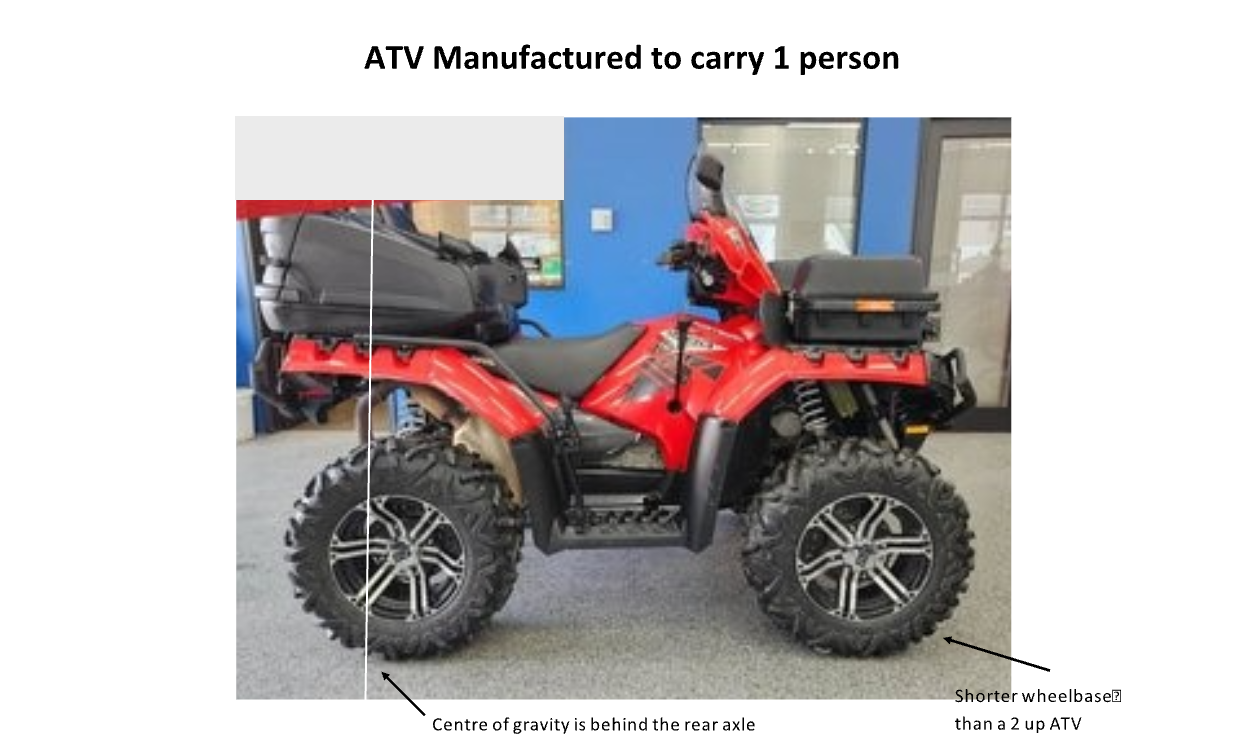In a concerning trend, a growing number of single-rider ATVs (1-up) are being ridden with a passenger, which is not how the machines were meant to be operated. Besides the inherent danger that comes with operating a vehicle in a manner that it wasn’t designed to be driven, there’s also the possibility of having the insurance voided should a claim need to be made.
To clear up the confusion, we interviewed Kristin Parsons, executive director of ATVBC, as well as Wayne Daub, general manager of the Canadian Quad Council & Motorcyclists Confederation of Canada (CQC).

ATVs manufactured to carry a passenger have some distinct features, as seen in the image above.
In regards to ATV safety, what are some of the basics when it comes to passenger safety?
Parsons: If you are going to carry a passenger, the most important safety tip is to ensure the driver has proper training to handle passengers on their machine. Adding an additional person to a machine increases the risk of roll over as the added weight and distribution can make the machine unstable. The driver must know how to maneuver the machine in all situations with this added weight, including during hill climbs and descents, sudden stops, and cornering.
Daub: Passengers should be wearing all the same safety gear as the driver, with the strongest emphasis on helmet, footwear and eye protection. Long pants, long-sleeve shirts, and gloves are important too.
If the passenger is on a traditional ATV, they are ‘active’ vehicles, which means leaning into a turn, leaning back down hill and forward uphill. Counter movements to the driver can have adverse effects on the ability to control the machine.
Which ATVs are appropriate for only one rider? Why?
Parsons: Most ATVs are built to carry one person, the driver, and don’t have the proper safety controls to handle an extra person. One-person ATVs have a shorter wheelbase, making it less stable and difficult to control when riding with two or more people.
Daub: ATVs built by the manufacturer are meant to carry a driver and no passenger (single rider ATVs). They have a shorter wheelbase, do not have a place for a passenger to sit, hold on or rest their feet. If a passenger cannot hold on and rest their feet, they are not able to effectively participate in rider active movements. If a single-rider ATV has a plastic seat added, the geometry of the machine can be severely compromised in its ability to remain stable in off-camber maneuvers. The weight of a second person on a single rider ATV is behind the rear axle, making the front end light.

Take note of the distinct differences when identifying an ATV manufactured to carry one person in the image above.
Which ATVs are capable and safe to ride with a passenger? Why?
Parsons: Manufactured 2-up machines (two-seaters) are built for two passengers. They have a longer wheelbase and proper seat and foot pedals for the passenger to sit properly and safely on the machine.
Daub: ATVs manufactured to carry a passenger have a longer wheelbase, additional seating in front of the rear axle, higher floor boards for the passenger to place their feet, and handles to hold on.
Is there a simple way for ATVers to identify the difference between the two types?
Parsons: You can tell the difference between the machines as 2-up machines feature:
- A longer wheelbase
- Dedicated foot pegs
- Secure passenger seat and riding handles that are bolted to the frame
Daub: A visual is easiest (see images). Manufacturer’s labels will discern a single-rider ATV from one that can carry a passenger.

When all else fails, look at the warning label on your ATV. The image on the left is from a single-rider ATV and clearly says “Never carry passengers.” The image on the right is from an ATV capable of carrying one passenger. It clearly says “Never carry MORE than 1 passenger.” — Photo courtesy Kristin Parsons
Why do you think there’s so much confusion for ATVers in regards to one-seater and two-seater ATVs?
Parsons: Aftermarket seats for ATVs have caused confusion for riders thinking if they can buy a seat, it must be allowed. This is simply not true in Canada. While many riders do add passengers to 1-up machines (one-seaters), it is clearly listed on the manufacturer details of the machine that it is a one-person machine only and authorities can fine riders who are carrying passengers on machines not built for two.
Daub: Aftermarket parts on a single rider ATV does not make it safe to carry a passenger.
How might insurance be voided with improper seating on an ATV?
Parsons: Insurance will always go with the manufacturer’s recommended use of the machine. If a rider is on a 1-up machine with a passenger, the likelihood of the insurance being void is very high.
Daub: Every province has different rules, and every case would be looked at individually. Human safety, in my mind, far outweighs insurance ramifications.
Is there anything else you’d like to mention?
Parsons: Read your machine’s manufacturer’s recommendations to learn more about how to use your machine and follow these guidelines to keep you and your passengers safe and avoid unnecessary risks or fines.








Comments